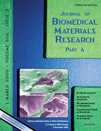Apatite-mineralized polycaprolactone nanofibrous web as a bone tissue regeneration substrate
Abstract
Degradable synthetic polymers with a nanofibrous structure have shown great promise in populating and recruiting cells for the reconstruction of damaged tissues. However, poor cell affinity and lack of bioactivity have limited their potential usefulness in bone regeneration. We produced polymeric nanofiber poly(ε-caprolactone) (PCL) with its surface mineralized with bone-like apatite for use as bone regenerative and tissue engineering matrices. PCL was first electrospun into a nanofibrous web, and the surface was further mineralized with apatite following a series of solution treatments. The surface of the mineralized PCL nanofiber was observed to be almost fully covered with nanocrystalline apatites. Through mineralization, the wettability of the nanofiber matrix was greatly improved. Moreover, the murine-derived osteoblastic cells were shown to attach and grow actively on the apatite-mineralized nanofibrous substrate. In particular, the mineralized PCL nanofibrous substrate significantly stimulated the expression of bone-associated genes, including Runx2, collagen type I, alkaline phosphatase, and osteocalcin, when compared with the pure PCL nanofiber substrate without mineralization. The currently developed polymer nanofibrous web with the bioactive mineralized surface is considered to be potentially useful as bone regenerative and tissue engineering matrices. © 2008 Wiley Periodicals, Inc. J Biomed Mater Res, 2009




